 |
Top Destinations |
|
|
|
 |
Travel Tools |
|
|
|
 |
|
|
Shanghai Attractions - Top sightseeing and things to
see
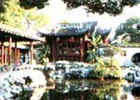 Yuyuan Garden, maybe the most celebrated classical Chinese garden in Shanghai,
is located in the northeast of the old town with an area of fives acres.
In 1559, a Ming official named Pan Yunduan launched the construction of
this private garden for his father's pleasure. The construction lasted
for 19 years. Later, due to the decline of the Pan family, the garden
gradually fell into oblivion. Furthermore, several civil conflicts in
the mid-19th century caused great damage to it. After several large-scale
re-constructions since 1949, Yu Yuan was finally opened to the public
in 1961. The garden each year attracts countless visitors at home and
abroad.
Yuyuan Garden, maybe the most celebrated classical Chinese garden in Shanghai,
is located in the northeast of the old town with an area of fives acres.
In 1559, a Ming official named Pan Yunduan launched the construction of
this private garden for his father's pleasure. The construction lasted
for 19 years. Later, due to the decline of the Pan family, the garden
gradually fell into oblivion. Furthermore, several civil conflicts in
the mid-19th century caused great damage to it. After several large-scale
re-constructions since 1949, Yu Yuan was finally opened to the public
in 1961. The garden each year attracts countless visitors at home and
abroad.
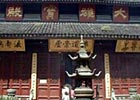 Jade Buddha Temple, the most famous Buddhist temple in Shanghai, is located
in west part of the city. In 1882, a monk named Huigen left two of five
jade Buddha statues brought from Burma in Shanghai and built a temple
there to keep them. In 1918, the old temple was burned down and a new
one was built in present site and named Jade Buddha Temple.
Jade Buddha Temple, the most famous Buddhist temple in Shanghai, is located
in west part of the city. In 1882, a monk named Huigen left two of five
jade Buddha statues brought from Burma in Shanghai and built a temple
there to keep them. In 1918, the old temple was burned down and a new
one was built in present site and named Jade Buddha Temple.
Still inhabited by monks, the temple consists of three main halls and
two courtyards.
The first hall is Tianwang Dian Hall where statues of the four celestial
kings and Maitreya are enshrined. It was said that the Maitreya in fact
is the Budai Monk. In 916, before his death, he had told people that he
was the reincarnation of the future Buddha Maitreya. Later, people called
him Buddha Maitreya and began to worship him in temples.
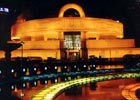 Shanghai museum, established in 1952, is located in People's Square, reputing
as one of the four largest museums in China. Covering a construction space
of 38,000 sqm, the museum is 29.5 meters high with five floors aboveground
and two underground.
Shanghai museum, established in 1952, is located in People's Square, reputing
as one of the four largest museums in China. Covering a construction space
of 38,000 sqm, the museum is 29.5 meters high with five floors aboveground
and two underground.
Opened to visitors at the end of 1995, the museum contains 120,000 cultural
relics of all the historical periods in ancient China, in which collections
of bronzes, ceramics, paintings, calligraphy and ancient sculptures are
among the best in China.
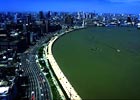 Cruising on the Huangpu River, one can enjoy a sight of rows of magnificent
buildings on the banks and ships of different sizes briskly playing Huangpu
River, originating in Dianshan Lake in Shanghai, runs its way for about
114 meters and finally flows into the East China Sea in Wusongkou. With
a width of 400 meters, the river is an important transporting route.
Cruising on the Huangpu River, one can enjoy a sight of rows of magnificent
buildings on the banks and ships of different sizes briskly playing Huangpu
River, originating in Dianshan Lake in Shanghai, runs its way for about
114 meters and finally flows into the East China Sea in Wusongkou. With
a width of 400 meters, the river is an important transporting route.
Boating along the Huangpu River, visitors could take a glimpse of the
yesterday and today of Shanghai. On one side of the river is the bund,
which is regarded a landmark as well as the birthplace of Shanghai. With
a length of 1 km, the bund is dotted with various grandiose solid buildings
of western style dating back to the early this century in its west. Due
to these imposing buildings, the bund is also reputed as "an international
exhibition of architecture". Comparing with the west, east of the
bund is a new developing Shanghai.
Now, a 646.7-meter-long sightseeing tunnel, connecting the bund to Oriental
Pearl TV Tower, was completed and opened to public in October 2000, through
which visitors can experience a marvelous trip under water.
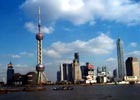 Situated within the Pudong Park in Lujiazui, Pudong New Area, Oriental
Pearl TV Tower, with a giddy height of 468 meters, is the world's third
tallest TV tower after the 553-meter CN Tower in Toronto and the 535-meter
Moscow TV Tower.
Situated within the Pudong Park in Lujiazui, Pudong New Area, Oriental
Pearl TV Tower, with a giddy height of 468 meters, is the world's third
tallest TV tower after the 553-meter CN Tower in Toronto and the 535-meter
Moscow TV Tower.
With a unique design composed of balls and columns, the tower become
Shanghai's new landmark and a big magnet for tourists. The designers magically
set the eleven beautiful spheres of various sizes up from the green grassland
to the blue sky with two giant spheres shining like two rubies. The whole
design is rich in poetic and pictorial splendor, which gives the tourists
the impression that pearls of various sizes are dropping onto the emerald
plate.
The Oriental Pearl Tower consists of three big columns, which are 9 meters
in diameter, the space module, the upper sphere, the lower sphere, five
small spheres, tower base and the square. In the tower, there is a double-decked
elevator, which can hold fifty people at a time, and two-speed elevator
that can run at a speed of 7 meters per second. The tower is equipped
with three-dimensional lighting installation, which makes the whole tower
very colorful and beautiful.
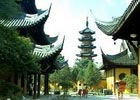 Located on the west bank of the Huangpujiang River south of Shanghai,
they are a famous attraction in Shanghai.
Located on the west bank of the Huangpujiang River south of Shanghai,
they are a famous attraction in Shanghai.
Longhua Temple: Longhua Temple, first built in 242 A.D during the Three
Kingdoms Period, is the biggest and oldest temple in Shanghai. The temple
was destroyed and rebuilt for many times. The present temple was built
during the reign of Emperor Guangxu of the Qing dynasty. Splendidly constructed,
the temple, till today, still keeps the original feature of Buddhist "chan"
sect of the Song dynasty. In the temple, Buddhist scripture, gold seals
and Buddhist statues of Tang, Ming and Qing dynasties are kept.
Longhua Pagoda: Standing opposite the Longhua temple, the pagoda, according
to historic documents, was built as early as the 3rd century. The present
pagoda, which is octagonal and seven-storied with 40.64 meters in height,
is the restoration in 977. Built of wood and bricks, this pagoda, with
upturned eaves and hanging bells in eaves' corners, is the only pagoda
in Shanghai city.
Till today, the temple, visited by large numbers of monks and laymen
each day, is still flourishing. At night on every New Year eve the ceremony
of "Striking the Longhua Evening Bell" is conducted here and
is well known at home and abroad. Each time, large numbers of people,
Chinese as well as foreign, come to listen to the ringing of the temple
bell.
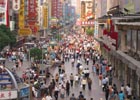 Along a short distance of five kilometer, Nanjing Road are concentrated
400 shops of every sort that are visited by 1.5 million shoppers daily.
Many of the stores are the largest in china. The No. 1 Department Store,
for example, sells over 40000 categories of goods, attracting 300,000
daily. Also located here are Shanghai's largest food shop, fashion boutiques,
drugstore, silk store, lamp store, bookstore and florists. Some of the
city's finest hotels, such as peace, Huaqiao and international, are also
located on the street.
Along a short distance of five kilometer, Nanjing Road are concentrated
400 shops of every sort that are visited by 1.5 million shoppers daily.
Many of the stores are the largest in china. The No. 1 Department Store,
for example, sells over 40000 categories of goods, attracting 300,000
daily. Also located here are Shanghai's largest food shop, fashion boutiques,
drugstore, silk store, lamp store, bookstore and florists. Some of the
city's finest hotels, such as peace, Huaqiao and international, are also
located on the street.
The street also boasts a variety of cultural spots, such as libraries,
art galleries, martial art clubs, sports clubs, acrobatics arenas and
cinemas.
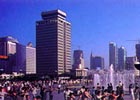 The People's Square is located in downtown Shanghai. Before liberation,
it was a race course. Now, you will find here the Municipal City Hall,
Shanghai Museum, Shanghai Grand Theater, No. l subway People's Square
stop, the underground shopping street, the underground transformer house,
the largest in Asia, an underground parking ground, the largest in Shanghai,
able to accommodate 600 cars. On both sides of the 600-m long and 32-m
wide People's Avenue are 5.5-m wide green belts and 6.5 -m wide passages
for non-motorized vehicles. In the middle of the square is a 320-sq.m.
round fountain and a landscaped lawn of 80,000 sq.m. In the western part
of the square are kept 1,000 pigeons. On holidays and at weekends the
square is crowded with people, enjoying the peaceful and pleasant scene
on the square.
The People's Square is located in downtown Shanghai. Before liberation,
it was a race course. Now, you will find here the Municipal City Hall,
Shanghai Museum, Shanghai Grand Theater, No. l subway People's Square
stop, the underground shopping street, the underground transformer house,
the largest in Asia, an underground parking ground, the largest in Shanghai,
able to accommodate 600 cars. On both sides of the 600-m long and 32-m
wide People's Avenue are 5.5-m wide green belts and 6.5 -m wide passages
for non-motorized vehicles. In the middle of the square is a 320-sq.m.
round fountain and a landscaped lawn of 80,000 sq.m. In the western part
of the square are kept 1,000 pigeons. On holidays and at weekends the
square is crowded with people, enjoying the peaceful and pleasant scene
on the square.
|
|
 |
Travel
Guides |
|
|
 |
|

